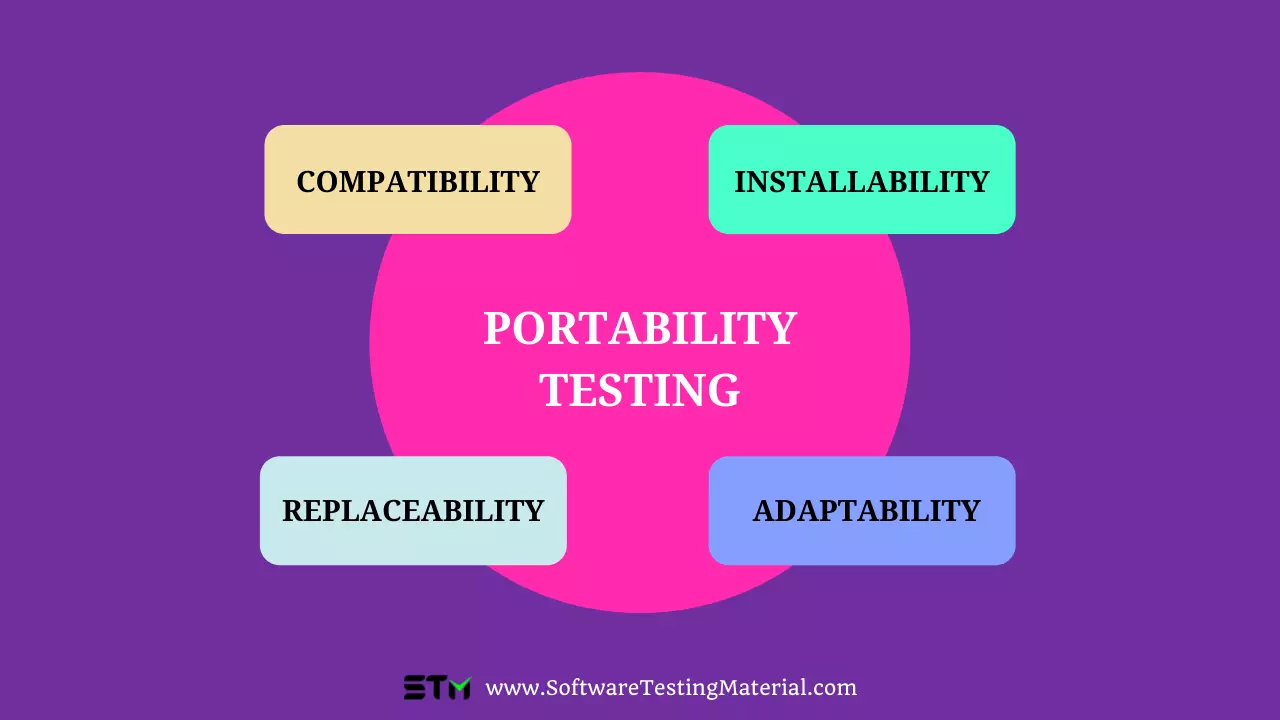What is Portability Testing in Software Testing

In this article we will see what is Portability Testing in Software Testing and the following
What is Portability Testing
Software portability testing is the process of determining whether or not a software application behaves in a manner that makes it compatible with another system, environment, or device.
The purpose of portability testing is to confirm that an application can be ported to another platform.
It is carried out on a regular basis throughout the SDLC in an iterative and incremental manner.
Examples of Portability Testing
As per portability testing use cases, an application should design in a manner that it must be migrated easily from one OS to another or one hardware platform to another or one web browser to another.
Examples of portable testing are as follows
- The application we develop should run on both Windows OS and Macintosh OS.
- The application we develop should be compatible with Google Chrome, IE, and Mozilla Firefox.
- The app we develop should run on iOS, and Android phones.
- The application we design should run on Windows MySQL server and Macintosh Oracle database.
- Installation and uninstallation of software in various OS.
The main aim for this type of testing is to make sure the applications are free from major defects and they don’t cause any failures or crashes when executed on another operating system or hardware architecture.
This will help improve the chances of success when the code has to be transferred across different platforms for execution i.e., compatibility.
Porting software is costly and time-consuming. Testing needs to be done so as to avoid further costs and failures during execution on different platforms. This aspect becomes all the more important when the applications need to be ported across hardware and software platforms.
The testing also validates whether or not an application can run on specific hardware, operating systems and computer networks without any compatibility issues.
For example, a future version of a popular operating system may have a significantly different interface design from its predecessor. If this new OS is installed in parallel with the current one, then robustness tests are conducted to assess how well the current release works with both versions of the OS.
Don’t miss: Simulator vs Emulator vs Real Device Testing
Portability Testing Attributes
The attributes of the portability Testing are as follows
- Installability
- Adaptability
- Replaceability
- Co-existence or Compatibility

#1. Installability
Installability is done to verify the ability to successfully install a software in a target environment.
It includes the following
- OS and Browser requirements
- Prerequisite verification
- RAM or memory requirements
- Installation procedures
- Installation interruptions
- Initialization & uninstallation procedure
#2. Adaptability
Adaptability is done to verify the ability of the software to be able to adapt to target environment.
It includes the following
- Hardware & software dependency.
- Standard language.
- Dependency across various systems.
#3. Replaceability
Replaceability is done to verify the ability of the software to be utilized in place of another designated product for the same purpose within the same environment.
The software that will be replacing the one currently in use must provide the same outcomes as the old software on all target platforms.
#4. Compatibility
Compatibility is done to verify the ability of the software to work with other independent software in a common environment without adversely affecting the behavior of each other.
This type of testing is particularly useful in large systems with many subsystems. The subsytems should ideally use the same stack area and memory. As a consequence, the failure of one subsystem may rapidly spread to the other subsystem, resulting in an application crash overall.
Changing a component that already exists is a difficult task, especially if it’s an established system. Components that fail compatibility testing requirements have a significant impact on the entire system and, as a result, they must be tested thoroughly for their influence on shared resources.
Portability Testing Checklists
The checklist contains the criteria that will be tested during the Portability Testing.
- Portability testing should fulfil the portability requirements.
- Testing the applications look and feel in multiple browser types and browser versions.
- Examine the application on various Operating Systems.
- It may be automated for continuous regression testing.
Different Types of Portability Testing
Functional portability testing
This type of testing evaluates how well software performs specific tasks on different platforms . The main aim is to check if the application can perform all its functions as expected. It validates that whether or not an application has been successfully ported to another platform. In this method, focus is mainly given on making sure that the product doesn’t have any functional errors because of porting it from one platform to another. Functional portability testing helps in reducing the number of defects discovered at later stages resulting from issues associated with compatibility and configurability . Testing focuses mainly on saving time by reducing the number of iterations and reducing testing efforts . This type of test is ideal during out-of-the-box release.
Don’t miss: How To Perform Functional Testing
Performance portability testing
The purpose of this type of testing is to determine whether or not a software application performs well on another platform. Testing team evaluates how fast the application completes its tasks when executed on another environment. In other words, if an application runs slower than expected or has issues with performance optimization then it fails the test. Performance portability testing helps in discovering defects that could lead to failures at later stages due to hardware compatibility issues.
Don’t miss: How To Perform Performance Testing
Software usability portability testing
It tests how easy it is for users in different environments to navigate through an application in terms of UI features, user interactions, etc. The purpose of this testing is to ensure that the product can be successfully ported across different platforms without sacrificing usability. It simply means that an application should be able to work on all platforms with same set of usability features.
Don’t miss: How To Perform Usability Testing
Software reliability portability testing
This type of testing focuses on evaluating how well applications perform in degraded conditions . In other words, this test validates whether or not the application works as expected even when it encounters hardware and software errors. How critical system failures are handled ? What happens if the program fails due to unpredictable conditions ? These are some issues that need to be determined by ensuring software reliability during portability testing .
Don’t miss: How To Perform Reliability Testing
Stress portability testing
Developing a stress free experience for-use is crucial for any successful application. This type of testing evaluates software performance under different load conditions so as to determine whether or not it can run smoothly for users even when there are huge data sets involved.
Don’t miss: How To Perform Stress Testing
Data migration portability testing
It validates how well an application performs during data transfer between platforms . During this process, focus is mainly given on evaluating how efficiently the program moves data across different platforms without any issues. For example, if there is a requirement of moving test data to production environment then running this test helps in identifying potential problems that might surface because of incompatibilities at later stages.
Feature portability testing
This type of testing validates features like scaling, high availability etc., beyond normal business scenarios. The purpose of this type of testing is to ensure that product doesn’t degrade even when subjected to large volumes of data or high number of transactions . This type of testing is done in order to determine whether or not the product can be ported successfully to another platform without compromising on critical features.
Error handling portability testing
It validates how well an application behaves in unusual conditions . Examines how graceful system fails so as to determine if proper fall-back mechanisms are followed . For example, if a program contains security feature then it should be able to block hackers from gaining access through loopholes. If the same feature fails during abnormal condition then it compromises with overall security mechanism. To address this concern, error handling portability testing is performed.
Compatibility portability testing
Software compatibility testing is done to ensure that an application can be successfully ported across different platforms without any compatibility or performance issues.
Don’t miss: How To Perform Compatibility Testing
Software installation portability testing
It validates how well the program gets installed on other devices . There are many cases where software fails to get installed completely due to incompatibilities. This testing validates whether or not the program gets installed correctly in all types of hardware environments.
Operational performance portability testing
This type of test determines if specific processes can run smoothly on another platform . Tests determine if the product meets required quality standards . For example, if a manufacturer has transferred its production line to other location then operational performance test ensures that manufacturing defects do not occur due to incompatible conditions.
Benchmark portability testing
Software benchmark testing is done to determine how fast a product can perform in different environments.
Don’t miss: How To Perform Benchmark Testing
Pros and Cons
There are several pros and cons in portability testing. Let’s take a look at each of them.
Pros
- Portability testing is done to find the dependencies between various components.
- It is preferred when we are performing testing on large systemw which have numerous subsystems that interact with one another.
- It is done when your client uses multiple OS and browser versions.
- It is used to find bugs that go undetected during unit and integration testing.
- It is used to test responsiveness and performance of an application on various opearting systems and browsers.
- It is used to test look and feel of the application on various opearting systems and browsers.
- The installation and un-installation of software may also be tested as part of Portability testing.
Cons
- It requires a huge investment in time and money because the test requires multiple configurations such as various operating systems and browsers.
- It’s not advised when there’s a deadline.
- Hosting environments might be costly.
Conclusion
Software testing is a huge field. There are many different types of tests that can be done, and there are also many ways to do them. The type we’ve looked at in this blog post—portability testing—is one way you might test your software when it comes time for release.
Portability testing is a type of software testing that ensures the application being tested will work on different types of computers with various hardware and operating systems. As you can see, portability testing is an important part in ensuring your applications are ready for release to the public.







